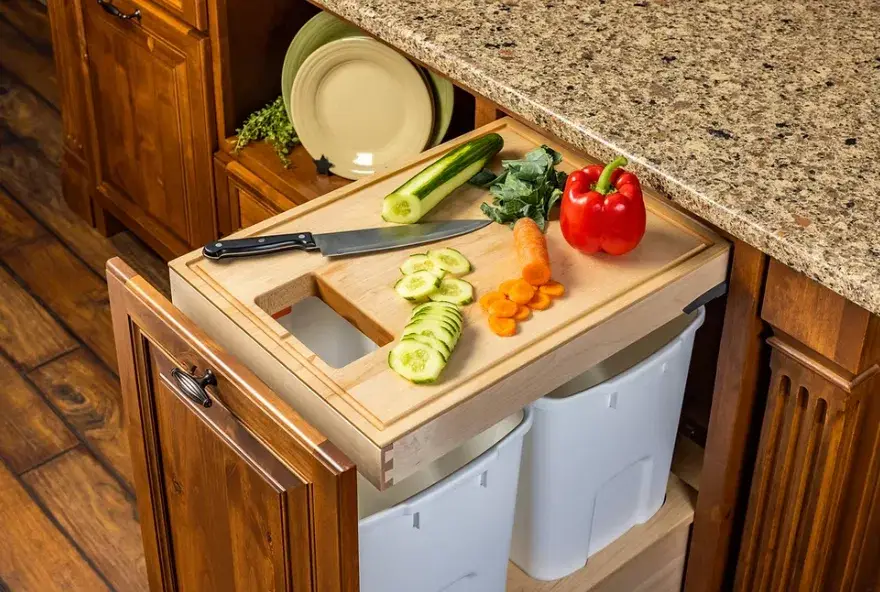The Hidden History of Kitchen Pull-Out Cutting Boards: From Bread-Making Stations to Modern Food Prep
In kitchens across America, tucked away beneath countertops and inside cabinet spaces, lies a piece of culinary history that most homeowners never think twice about. The pull-out cutting board, now commonly used for chopping vegetables and general food preparation, has a fascinating origin story that reveals how dramatically our cooking habits have evolved over the past century.
The Original Purpose: Dedicated Bread-Making Surfaces
These wooden boards weren’t originally designed for cutting at all. Long before the era of stand mixers, bread machines, and spacious granite countertops, home bakers relied on these sturdy pull-out surfaces as dedicated bread-making stations. In an age when baking bread was a weekly ritual in most households, these boards served as the command center for one of cooking’s most fundamental processes.
The smooth, expansive wooden surface provided the ideal workspace for kneading dough, shaping loaves, and managing the multiple steps involved in traditional bread making. Unlike modern countertops that might be too high, too low, or made from materials unsuitable for working with sticky dough, these boards were positioned at the perfect height and crafted specifically for the demands of bread preparation.
In the early 1900s, when most families baked their own bread out of necessity rather than choice, these boards saw daily use. The process typically began before dawn, with mothers or designated family bakers pulling out the smooth wooden surface to begin the day’s bread preparation. The familiar rhythm of kneading dough on these boards became as routine as any other household chore, creating a soundtrack of productivity that defined domestic life.
Practical Design for Practical Times
Early 20th-century kitchens were designed around efficiency and multi-functionality. Space was often limited, and every element needed to serve multiple purposes while maintaining a tidy appearance. The pull-out bread board exemplified this philosophy perfectly.
When not in use, the board could be neatly tucked back into its cabinet space, keeping the kitchen uncluttered and the work surface protected from dust or damage. This retractable design was particularly valuable in smaller kitchens where permanent counter space was at a premium.
The boards were typically made from hard maple or similar dense woods that could withstand the repetitive kneading motions and occasional rolling pin use that bread making required. The wood’s natural properties made it ideal for working with yeast doughs, as it provided just enough friction for effective kneading without sticking to wet ingredients.
Cabinet makers of the era understood that these boards would endure significant stress. The mounting systems were engineered to support substantial weight and lateral pressure from vigorous kneading activities. Many original installations from this period continue to function smoothly today, testament to the quality of both materials and craftsmanship involved in their creation.
Regional Variations and Cultural Differences
The design and implementation of pull-out cutting boards varied significantly across different regions of the United States, reflecting local building traditions and cultural cooking practices. In the Northeast, where German and Scandinavian immigrants brought strong bread-making traditions, these boards were often larger and more elaborate, sometimes featuring raised edges to contain flour during kneading sessions.
Southern kitchens frequently incorporated pull-out boards into pantry areas rather than main cooking spaces, reflecting the region’s emphasis on preserving and preparing large quantities of food during harvest seasons. These boards often served double duty for tasks like rolling out pie crusts and preparing biscuit dough, essential components of Southern cuisine.
In the Midwest, where agricultural communities relied heavily on home-baked bread to feed large farming families, pull-out boards were considered essential equipment rather than convenient accessories. Many were custom-built by local carpenters to exact specifications, with reinforced supports to handle the substantial amounts of dough required for feeding extended families and seasonal workers.
Western frontier kitchens often featured more utilitarian versions, built from whatever quality wood was locally available. These boards needed to be particularly durable, as replacement parts and professional repairs were often impossible to obtain in remote locations.
The Evolution from Specialized to Universal
As American cooking habits shifted throughout the mid-to-late 20th century, the role of these pull-out boards began to change dramatically. Several factors contributed to this transformation:
Declining Home Bread Production: The rise of commercial bakeries and readily available store-bought bread meant fewer families were baking their own loaves regularly. The Wonder Bread era of the 1950s and 1960s marked a significant departure from traditional home baking, making the specialized bread-making function of these boards less relevant to daily kitchen use.
Changing Kitchen Designs: Modern kitchens began featuring larger countertops and more prep space, reducing the need for additional work surfaces. The suburban kitchen boom of the post-war era emphasized spacious layouts with ample permanent counter space, diminishing the space-saving advantages that pull-out boards originally provided.
Increased Food Preparation Variety: As cooking became more varied and international cuisines gained popularity, home cooks needed more chopping and prep space for vegetables, herbs, and other ingredients that required cutting rather than kneading. The rise of television cooking shows and international food availability introduced Americans to cooking techniques that demanded different types of preparation surfaces.
Practical Adaptation: Homeowners naturally began using these convenient, accessible wooden surfaces for whatever food preparation tasks they were performing, transforming them from specialized tools into general-purpose cutting boards.
The Craftsmanship Behind the Boards
The construction of these pull-out boards represented a sophisticated understanding of both woodworking and kitchen functionality. Master carpenters selected wood carefully, choosing pieces with straight, tight grain that would resist warping under repeated exposure to moisture and temperature changes. The boards were often cut from a single piece of lumber to eliminate joints where bacteria might accumulate.
Installation required precise measurements and expert fitting, as the boards needed to slide smoothly without binding while maintaining stability during vigorous kneading activities. Many featured ingenious support mechanisms, including wooden guides and metal tracks that distributed weight evenly and prevented sagging over time.
The finishing process was equally important, with most boards receiving multiple coats of food-safe oils that penetrated deep into the wood grain. This treatment not only protected the surface but also enhanced the wood’s natural antimicrobial properties and created the smooth texture essential for effective bread making.
Quality boards from this era often featured subtle details that revealed the craftsman’s skill: perfectly rounded edges to prevent stress concentrations, carefully calculated clearances to prevent binding, and support systems designed to last for generations of daily use.
Why Maple Wood Endures
Despite the availability of modern materials like bamboo, plastic, and composite surfaces, maple wood remains a preferred choice for cutting boards, both pull-out varieties and standalone versions. This preference isn’t merely nostalgic—it’s based on several practical advantages:
Durability: Maple’s dense grain structure resists deep cuts and gouges that can harbor bacteria, making it safer for food preparation than softer woods or easily-scratched surfaces.
Knife Preservation: The wood’s hardness provides enough resistance for effective cutting while being gentle enough to preserve sharp knife edges, unlike stone or glass surfaces that can quickly dull blades.
Natural Antimicrobial Properties: Research has shown that wood surfaces, particularly hardwoods like maple, have natural antimicrobial properties that can actually help reduce bacterial contamination over time.
Self-Healing: Minor cuts and scratches in maple wood tend to close up slightly over time, maintaining a relatively smooth surface even after extensive use.
Maintenance Simplicity: With proper care—regular cleaning and occasional oiling—maple cutting boards can last for decades, making them both economical and environmentally sustainable.
Modern Restoration and Appreciation
Today, there’s growing interest in restoring and maintaining vintage pull-out cutting boards, driven partly by the renewed popularity of artisanal bread making and appreciation for traditional craftsmanship. Home renovation enthusiasts often discover these boards during kitchen remodels and face decisions about whether to preserve, restore, or remove them.
Restoration typically involves careful sanding to remove accumulated stains and damage, followed by proper conditioning with mineral oil or specialized wood treatments. Many homeowners find that properly restored boards not only function better than modern alternatives but also add character and historical value to their kitchens.
The process often reveals the exceptional quality of original construction, with many boards showing minimal structural deterioration even after decades of intensive use.
The Modern Legacy
While most contemporary homes don’t include pull-out cutting boards in their original form, their influence persists in modern kitchen design. Today’s kitchen islands, expandable countertops, and modular prep stations all reflect the same underlying principle: the need for flexible, functional workspace that can adapt to different cooking tasks.

Lila Hart is a dedicated Digital Archivist and Research Specialist with a keen eye for preserving and curating meaningful content. At TheArchivists, she specializes in organizing and managing digital archives, ensuring that valuable stories and historical moments are accessible for generations to come.
Lila earned her degree in History and Archival Studies from the University of Edinburgh, where she cultivated her passion for documenting the past and preserving cultural heritage. Her expertise lies in combining traditional archival techniques with modern digital tools, allowing her to create comprehensive and engaging collections that resonate with audiences worldwide.
At TheArchivists, Lila is known for her meticulous attention to detail and her ability to uncover hidden gems within extensive archives. Her work is praised for its depth, authenticity, and contribution to the preservation of knowledge in the digital age.
Driven by a commitment to preserving stories that matter, Lila is passionate about exploring the intersection of history and technology. Her goal is to ensure that every piece of content she handles reflects the richness of human experiences and remains a source of inspiration for years to come.
